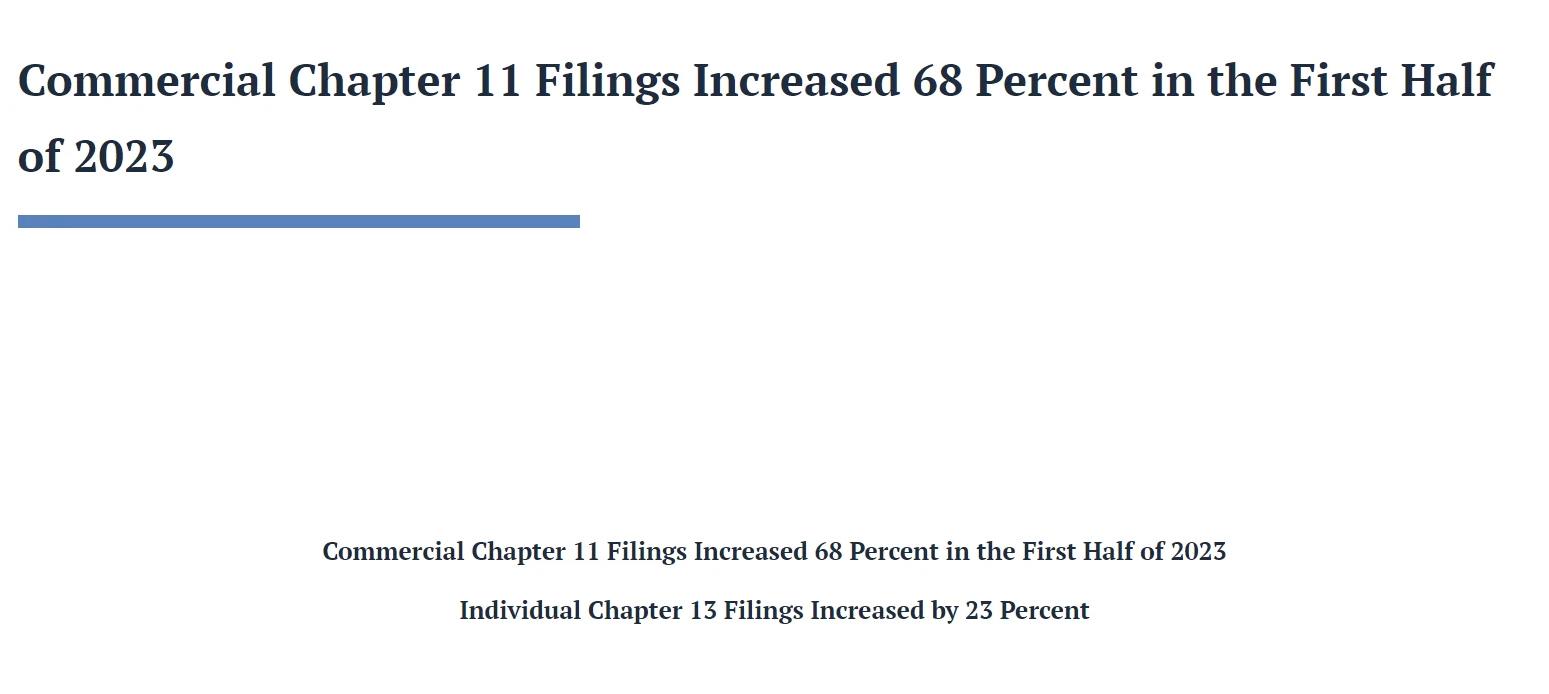
The 2,973 total commercial chapter 11 bankruptcies filed during the first six months of 2023 represented a 68 percent increase over the 1,766 filed during the same period in 2022, according to data provided by Epiq Bankruptcy, the leading provider of U.S. bankruptcy filing data. Individual chapter 13 filings increased by 23 percent during the same period.
Overall commercial filings registered 12,107 for the first half of 2023, representing an 18 percent increase from the commercial filing total of 10,258 for the first half of 2022. Small business filings, captured as subchapter V elections within chapter 11, totaled 814 in the first six months of 2023, a 55 percent increase from the 525 elections during the same period in 2022.
Overall commercial filings increased 12 percent in June 2023, as the 2,123 filings were up from the 1,891 commercial filings registered in June 2022. The 404 commercial chapter 11 filings in June represented a 9 percent increase from the 371 filings in June 2022. Total subchapter V elections within chapter 11, experienced a 111 percent increase from 94 in June 2022 to 198 in June 2023.
“The increase in commercial and individual bankruptcy filings during the first half of 2023 underscores the economic challenges faced by businesses and individuals,” said Gregg Morin, Vice President of Business Development and Revenue at Epiq Bankruptcy. “Our objective is to provide bankruptcy professionals with timely and accurate data necessary for analyzing stakeholder volumes and trends for making informed business decisions.”
Total bankruptcy filings were 217,420 during the first six months of 2023, a 17 percent increase from the 185,352 total filings during the same period a year ago. Total individual filings also registered a 17 percent increase, as the 205,313 filings during the first half of 2023 were up from the 175,094 filings during the first six months of 2022. The 85,390 individual chapter 13 filings in the first half of 2023 represent a 23 percent increase over the 69,367 filings during the same period in 2022.
All chapters increased in June 2023 compared to June 2022, with 37,700 total bankruptcy filings representing an increase of 17 percent from the 32,198 filed in 2022. Total commercial filings were up 12 percent from 1,891. Total Individuals were up 18 percent from 30,307.
“The growth in filings is reflective of more families and businesses facing surging debt loads due to rising interest rates, inflation, and increased borrowing costs,” said ABI Executive Director Amy Quackenboss. “Bankruptcy provides a shield to the economic challenges being experienced by financially struggling individuals and companies.”
The substantial year-over-year increase in subchapter V elections reflects statutory developments that took place last year. The Bankruptcy Threshold Adjustment and Technical Corrections Act was quickly enacted in June 2022 to restore the debt eligibility limit for small businesses back to $7.5 million while also increasing the debt limit for individual chapter 13 filings to $2.75 million and removing the distinction between secured and unsecured debt for that calculation. The increased eligibility limits for both Subchapter V and Chapter 13 were currently set to sunset on June 21, 2024.
Wut mean?
- Commercial Chapter 11 Bankruptcies: There were 2,973 filings in the first half of 2023, a 68% increase from the 1,766 filed in the same period in 2022.
- Individual Chapter 13 Filings: These increased by 23% during the same period.
- Overall Commercial Filings: There were 12,107 filings in the first half of 2023, an 18% increase from the 10,258 in the first half of 2022.
- Small Business Filings (Subchapter V): There were 814 filings in the first half of 2023, a 55% increase from the 525 in the same period in 2022.
- June 2023 Filings: Commercial filings increased 12% to 2,123, and commercial Chapter 11 filings increased 9% to 404. Subchapter V elections increased 111% to 198.
- Total Bankruptcy Filings: There were 217,420 filings in the first half of 2023, a 17% increase from the 185,352 in the same period in 2022.
- Total Individual Filings: These increased 17% to 205,313 in the first half of 2023, from 175,094 in the first half of 2022.
- Individual Chapter 13 Filings: There were 85,390 filings in the first half of 2023, a 23% increase from the 69,367 in the same period in 2022.
- June 2023 vs June 2022: Total bankruptcy filings increased 17% to 37,700. Commercial filings were up 12% from 1,891, and total individual filings were up 18% from 30,307.
These statistics show a significant increase in bankruptcy filings, both for businesses and individuals.
We are going to see more bankruptcies, remember this from the other day?
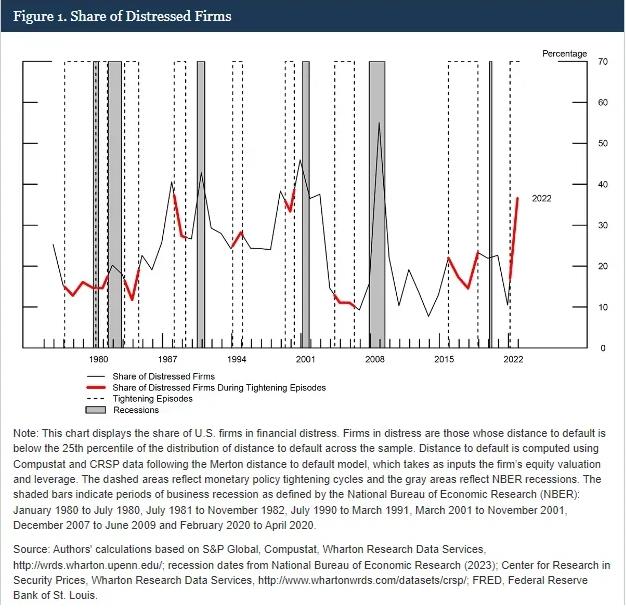
Wut mean?
- Since March 2022, U.S. monetary policy has become tighter. More businesses are financially distressed now than in previous instances of tightening since the ’70s.
- Studies suggest that these conditions could lead to significant declines in investment and jobs in the near future.
- The theory is that when monetary policy gets tougher, distressed firms find it harder to secure external funding compared to healthy firms.
- These troubled companies then cut down on investments and jobs more than their healthier counterparts.
- On the other hand, when policy is eased, both types of firms respond similarly and weakly, not affecting investment and job rates dramatically.
- Data from U.S. nonfinancial firms from 1990 to 2022 was used for this analysis.
- To measure the potential for a firm’s default, they used a system called “distance to default”, which they claim is better than other methods to predict borrowing ability.
- The findings show that tight monetary policy has a stronger impact on investment and jobs than easy policy.
- Also, distressed firms react more severely to a tight policy by reducing their investment significantly, while healthy firms’ reactions are negligible.
- Both types of firms didn’t show a significant change in investment in response to easy policy.
- The evidence suggests that how hard a monetary policy hits, particularly when it’s getting tighter, is stronger when there are more distressed firms around.
- So, this current cycle of monetary tightening, with a high number of firms in distress, could potentially lead to significant impacts on investment, jobs, and overall economic activity.
- These effects could become more noticeable in 2023 and 2024.
On the consumer side, things are not any better:
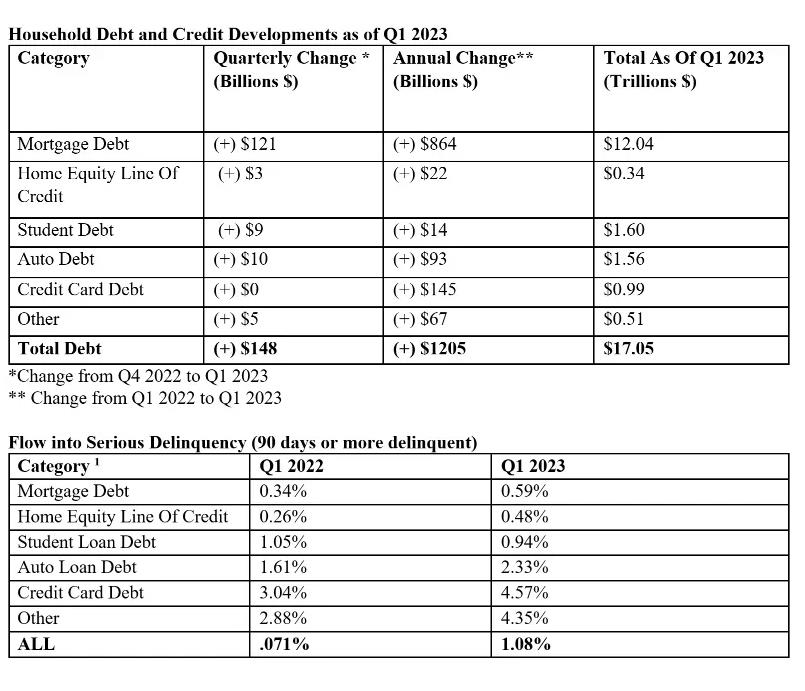

- Total household debt has risen by $148 billion, or 0.9 percent, to $17.05 trillion in the first quarter of 2023.
- Mortgage balances climbed by $121 billion and stood at $12.04 trillion at the end of March.
- Auto loans to $1.56 trillion.
- Student loans to $1.60 trillion.
- Credit Card debt $986 billion.
However, unlike the banks above, there are no fancy programs designed to keep households afloat in this inflating economy–and boy are households starting to feel it, especially in the areas like services and housing (that are BIG components of CPI–and way more ‘sticky’ than goods).
For example, on the housing front:
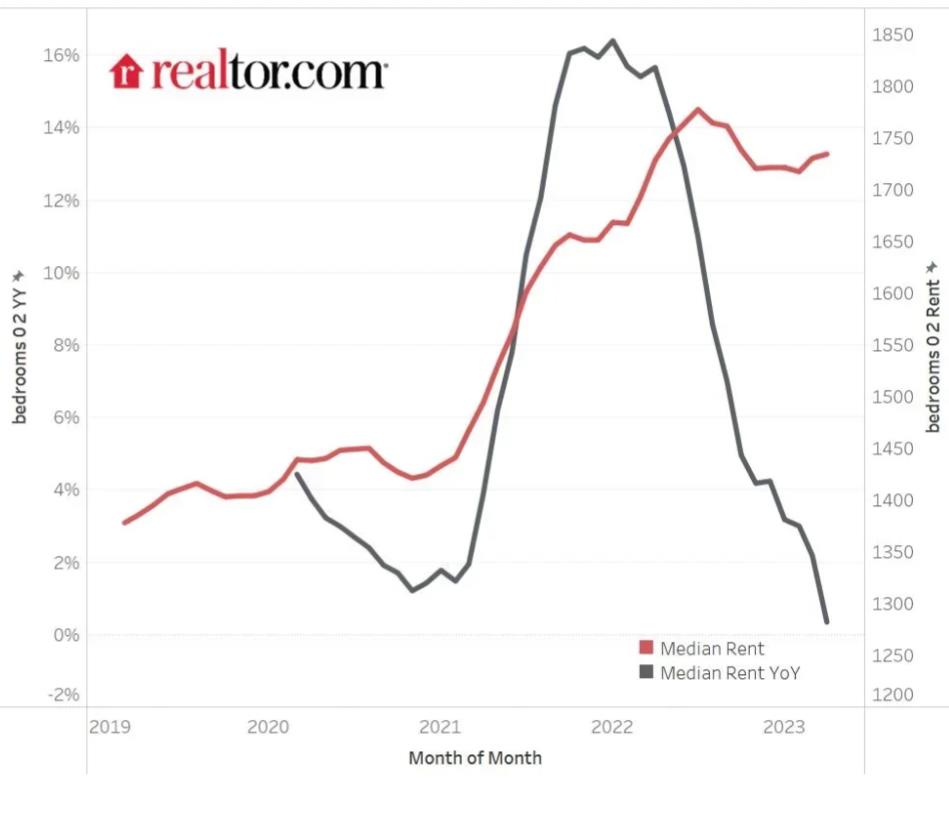
To try and further drive home the shaky ground households are on, let’s revisit the Fed’s Economic Well-being US Household 2022.
- “fewer adults reported having money left over after paying their expenses. 54% of adults said that their budgets had been affected “a lot” by price increases.”
- “51% of adults reported that they reduced their savings in response to higher prices.”
- The share of adults who reported that they would cover a $400 emergency expense using cash or its equivalent was 63 percent.
It is the younger generations starting to see itself break into delinquency now:
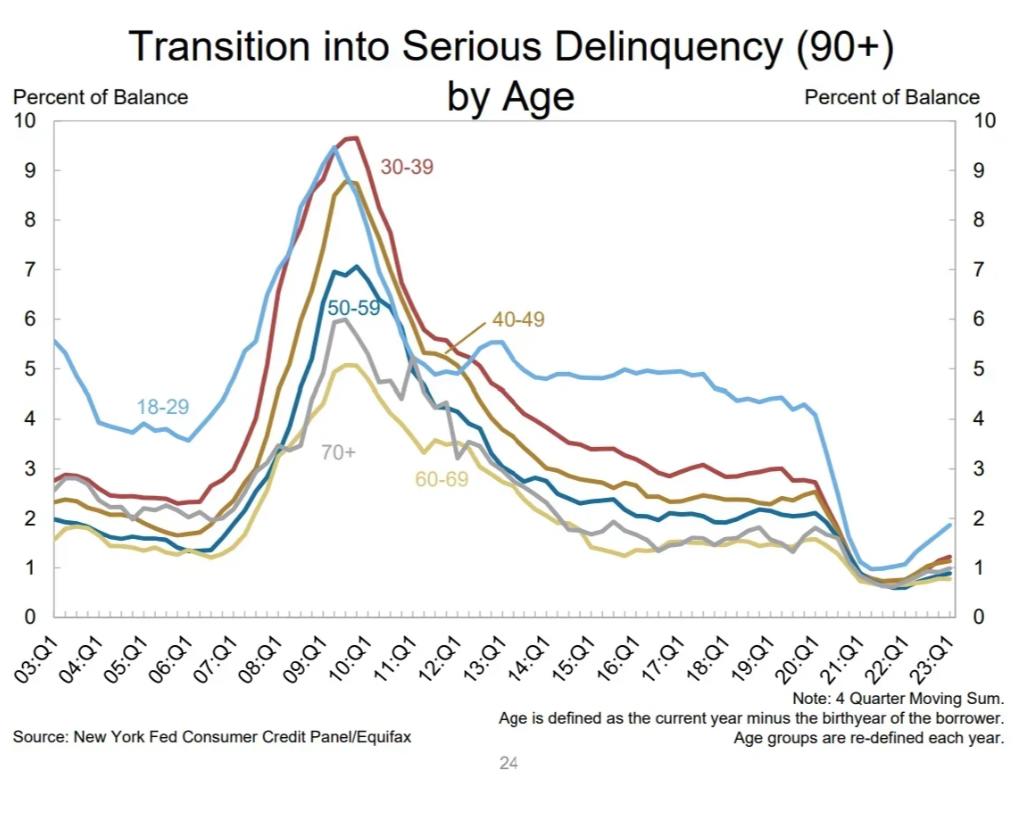
Student Loan repayments restarting in October WILL lead to more defaults:
People are going to die because of this:
To meet the rising need for food and nutrition assistance during the pandemic in the United States, all states were approved to provide Emergency Allotments (EA) to households enrolled in the Supplemental Nutrition Assistance Program (SNAP). In this analysis, we use the Census Bureau’s Household Pulse Surveys and exploit staggered state-level variation in dissolution of the SNAP EA payments to study whether the end of EA is associated with food-related challenges and economic hardships. Our findings indicate that EA termination is followed by a decrease in the likelihood that adult survey respondents had sufficient food for consumption and an increase in the probability of experiencing difficulty in paying meeting with usual household expenses. These findings provide policy-relevant insights into the potential impact of the nationwide termination of the EA payments that came into effect in early 2023.

- Auto loans are above 3% delinquency for (30-39) and approaching 5% for (18-29)
- Credit Cards are above 6% delinquency for (30-39) and approaching 9% for (18-29)
- Student Loan delinquency is being artificially suppressed currently.
- When folks (18-29) and (30-39) have to pay Auto loans, Credit Card debt, and Student loans all at the same time, delinquencies across all 3 will jump bigly.
- People will DIE being priced out of their lives in favor of raising interest rates to fight inflation for a problem the Fed created to begin with.
TLDRS:
- Bankruptcy filings, both for businesses and individuals, have significantly increased in the first half of 2023 compared to the same period in 2022.
- I try and show it is only setup to start getting worse come October.
- Reminder, while banks have the liquidity fairy, ‘we’ get the promise of 2 more rate hikes this year, Atlanta Fed President Raphael Bostic yet again enrichens himself inappropriately from his position.
- To fix one end of their mandate (price stability) from the inflation problem they created, the Fed will continue sacrificing employment (the other end of their mandate) to bolster price stability by continuing to raise interest rates–causing further stress for the businesses and households identified above.
219 views